2013 VOLKSWAGEN TOUAREG Trailer hitch
[x] Cancel search: Trailer hitchPage 1 of 440

Side view
Fig. 1 Vehicle side overview.
Key to fig. 1:
(1) Fuel filler flap
(2) Side window with window diversity antenna for:
– Radio
– Central locking
(3) Roof antenna for:
– Cell phone
– Navigation
(4) Roof rack
(5) Outside door handle
(6) Outside mirror
– Additional turn signal light
(7) Lift points for the jack
(8) Receiver for the trailer hitch
Page 3 of 440

Rear view
Fig. 3 Vehicle rear overview.
Key to fig. 3:
(1) Roof antenna for:
– Cell phone
– Navigation
(2) High-mounted brake light
(3) Rear window
– Rear window defroster
(4) Rear window wiper
(5) Taillights
(6) Area of:
– Button to open the rear hatch
– Camera of the Rear Assist
– License plate lighting
(7) Rear license plate bracket
(8) Sensors for rear Park Distance Control
(9) Rear towing eye mount behind a cover
(10) Receiver for the trailer hitch
Page 42 of 440

Unlocking and locking the rear hatch (Keyless Entry for the rear hatch)
If the vehicle is locked and a valid vehicle key is within range A of the rear hatch, it unlocks automati-
cally when opened.
�x Open and close the rear hatch as you would a standard rear hatch.
The rear hatch locks automatically when it is closed except in the following situations:
�x The vehicle is completely unlocked.
�x When an authorized vehicle key is inside the vehicle.
Sensor-controlled rear hatch opener (Easy Open)
When a valid vehicle key is within range A of the rear hatch, the rear hatch can be unlocked and
opened by moving your foot within the sensor’s range ⇒ fig. 26 below the rear bumper.
�x Switch off the ignition and remove any vehicle key in the ignition.
�x Stand in front of the middle of the rear bumper.
�x Quickly move the side of your body, your foot and shin as close to the bumper as possible. Your
shin must be in the upper part of the sensor’s range and your foot in the lower part (1).
�x Quickly move your shin out of range (2). The rear hatch opens automatically.
The high-mounted brake light and the turn signals flash once to show that the Easy Open feature is
opening the rear hatch.
The rear hatch locks automatically after closing if the vehicle was locked before and a valid vehicle key
is not inside the vehicle. If the vehicle key used to open the vehicle is inside the vehicle, the rear hatch
opens again.
Easy Open may not work properly or at all in the following situations (examples):
�x If the rear bumper is very dirty.
�x If the rear bumper has salty water on it after driving on salted roads.
�x If a trailer hitch has been retrofit on the vehicle.
Easy Open may be automatically deactivated in heavy rain to help prevent unintentional deployment
caused by water running down the vehicle, for example.
Locking with a second vehicle key
If a remote control vehicle key is inside the passenger compartment, the vehicle can be locked from
the outside only if a second valid key is within range.
A key that was inside the vehicle when it was locked from the outside is reactivated:
�x By pressing a button on the deactivated key.
�x By pressing a door handle sensor when the deactivated key is outside of the vehicle, but within
range.
�x By starting the engine with the starter button on the front center console.
Automatic deactivation of sensors
If the vehicle has not been unlocked or locked for a longer period of time, the proximity sensors in the
passenger door are automatically deactivated.
If a sensor on the door handle of a locked vehicle is activated too often, for instance by a bush or
hedge that rubs against the vehicle, the sensors in the door handle on that side of the vehicle are
switched off for 30 minutes.
The sensors become active again when the vehicle is locked with the vehicle key and the ignition is
switched on one time.
The sensors become active again if one of the following events occurs:
�x 30 minutes have passed.
�x OR: The vehicle is unlocked using the V button in the remote control vehicle key.
Page 148 of 440
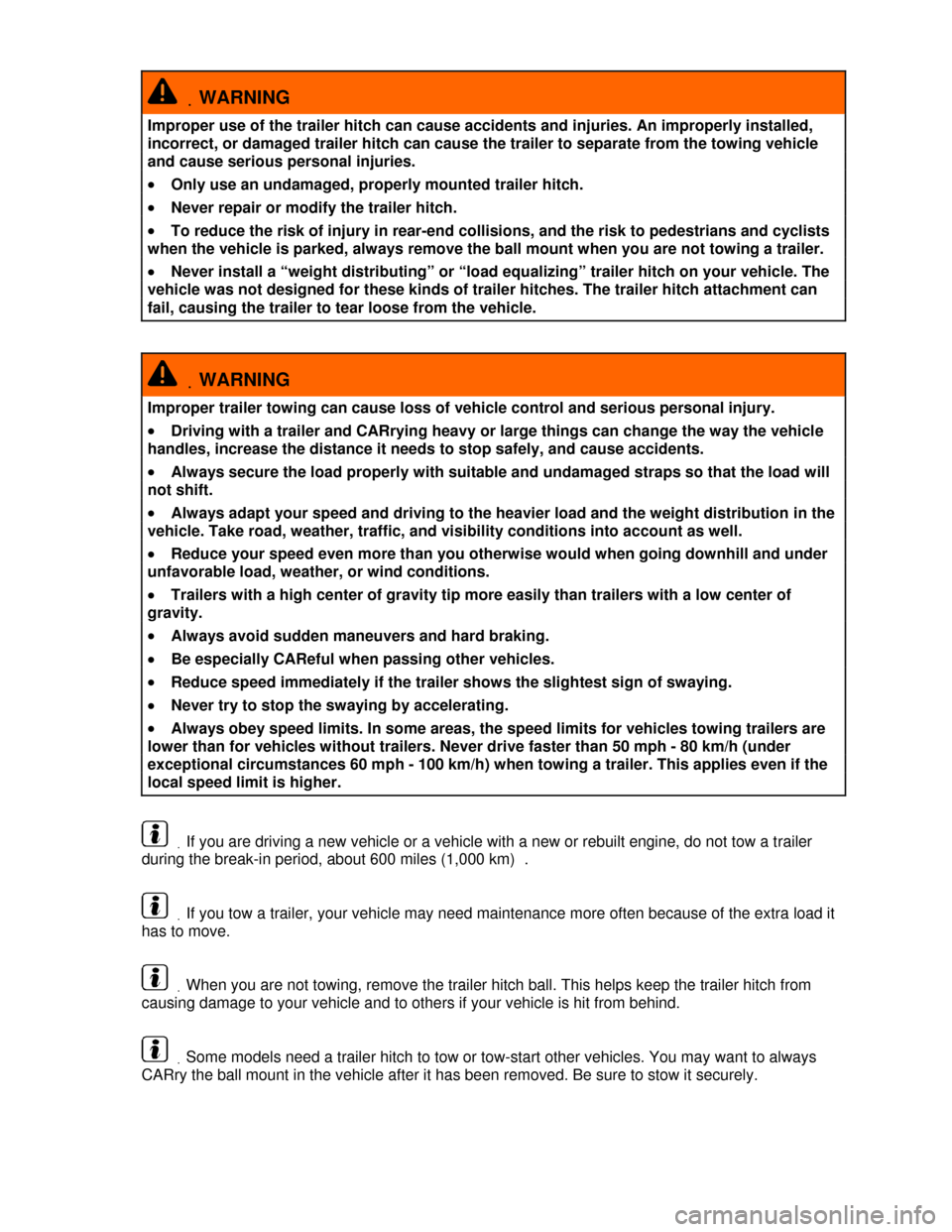
.WARNING
Improper use of the trailer hitch can cause accidents and injuries. An improperly installed,
incorrect, or damaged trailer hitch can cause the trailer to separate from the towing vehicle
and cause serious personal injuries.
�x Only use an undamaged, properly mounted trailer hitch.
�x Never repair or modify the trailer hitch.
�x To reduce the risk of injury in rear-end collisions, and the risk to pedestrians and cyclists
when the vehicle is parked, always remove the ball mount when you are not towing a trailer.
�x Never install a “weight distributing” or “load equalizing” trailer hitch on your vehicle. The
vehicle was not designed for these kinds of trailer hitches. The trailer hitch attachment can
fail, causing the trailer to tear loose from the vehicle.
.WARNING
Improper trailer towing can cause loss of vehicle control and serious personal injury.
�x Driving with a trailer and CARrying heavy or large things can change the way the vehicle
handles, increase the distance it needs to stop safely, and cause accidents.
�x Always secure the load properly with suitable and undamaged straps so that the load will
not shift.
�x Always adapt your speed and driving to the heavier load and the weight distribution in the
vehicle. Take road, weather, traffic, and visibility conditions into account as well.
�x Reduce your speed even more than you otherwise would when going downhill and under
unfavorable load, weather, or wind conditions.
�x Trailers with a high center of gravity tip more easily than trailers with a low center of
gravity.
�x Always avoid sudden maneuvers and hard braking.
�x Be especially CAReful when passing other vehicles.
�x Reduce speed immediately if the trailer shows the slightest sign of swaying.
�x Never try to stop the swaying by accelerating.
�x Always obey speed limits. In some areas, the speed limits for vehicles towing trailers are
lower than for vehicles without trailers. Never drive faster than 50 mph - 80 km/h (under
exceptional circumstances 60 mph - 100 km/h) when towing a trailer. This applies even if the
local speed limit is higher.
.If you are driving a new vehicle or a vehicle with a new or rebuilt engine, do not tow a trailer
during the break-in period, about 600 miles (1,000 km) .
.If you tow a trailer, your vehicle may need maintenance more often because of the extra load it
has to move.
.When you are not towing, remove the trailer hitch ball. This helps keep the trailer hitch from
causing damage to your vehicle and to others if your vehicle is hit from behind.
.Some models need a trailer hitch to tow or tow-start other vehicles. You may want to always
CARry the ball mount in the vehicle after it has been removed. Be sure to stow it securely.
Page 150 of 440
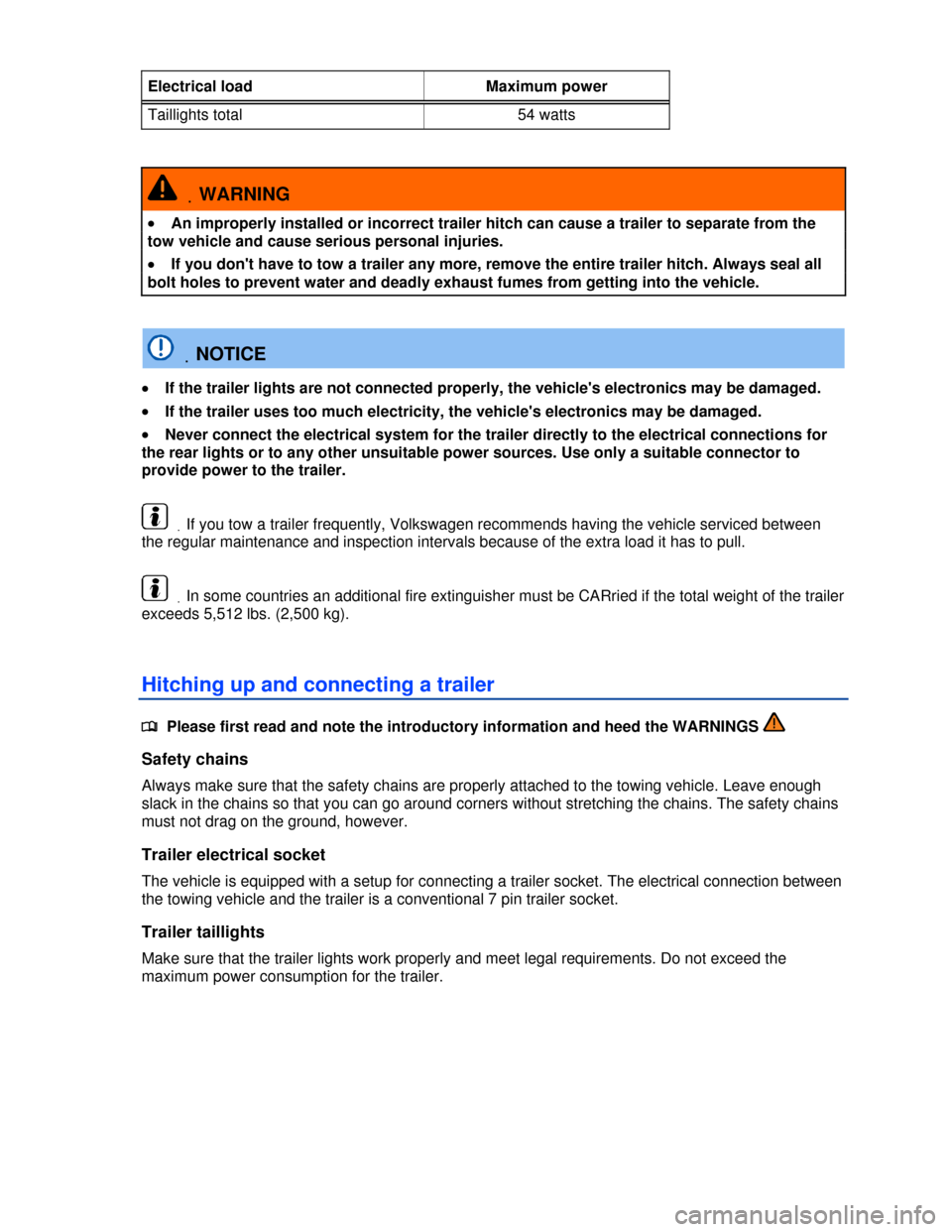
Electrical load Maximum power
Taillights total 54 watts
.WARNING
�x An improperly installed or incorrect trailer hitch can cause a trailer to separate from the
tow vehicle and cause serious personal injuries.
�x If you don't have to tow a trailer any more, remove the entire trailer hitch. Always seal all
bolt holes to prevent water and deadly exhaust fumes from getting into the vehicle.
.NOTICE
�x If the trailer lights are not connected properly, the vehicle's electronics may be damaged.
�x If the trailer uses too much electricity, the vehicle's electronics may be damaged.
�x Never connect the electrical system for the trailer directly to the electrical connections for
the rear lights or to any other unsuitable power sources. Use only a suitable connector to
provide power to the trailer.
.If you tow a trailer frequently, Volkswagen recommends having the vehicle serviced between
the regular maintenance and inspection intervals because of the extra load it has to pull.
.In some countries an additional fire extinguisher must be CARried if the total weight of the trailer
exceeds 5,512 lbs. (2,500 kg).
Hitching up and connecting a trailer
�
Page 151 of 440
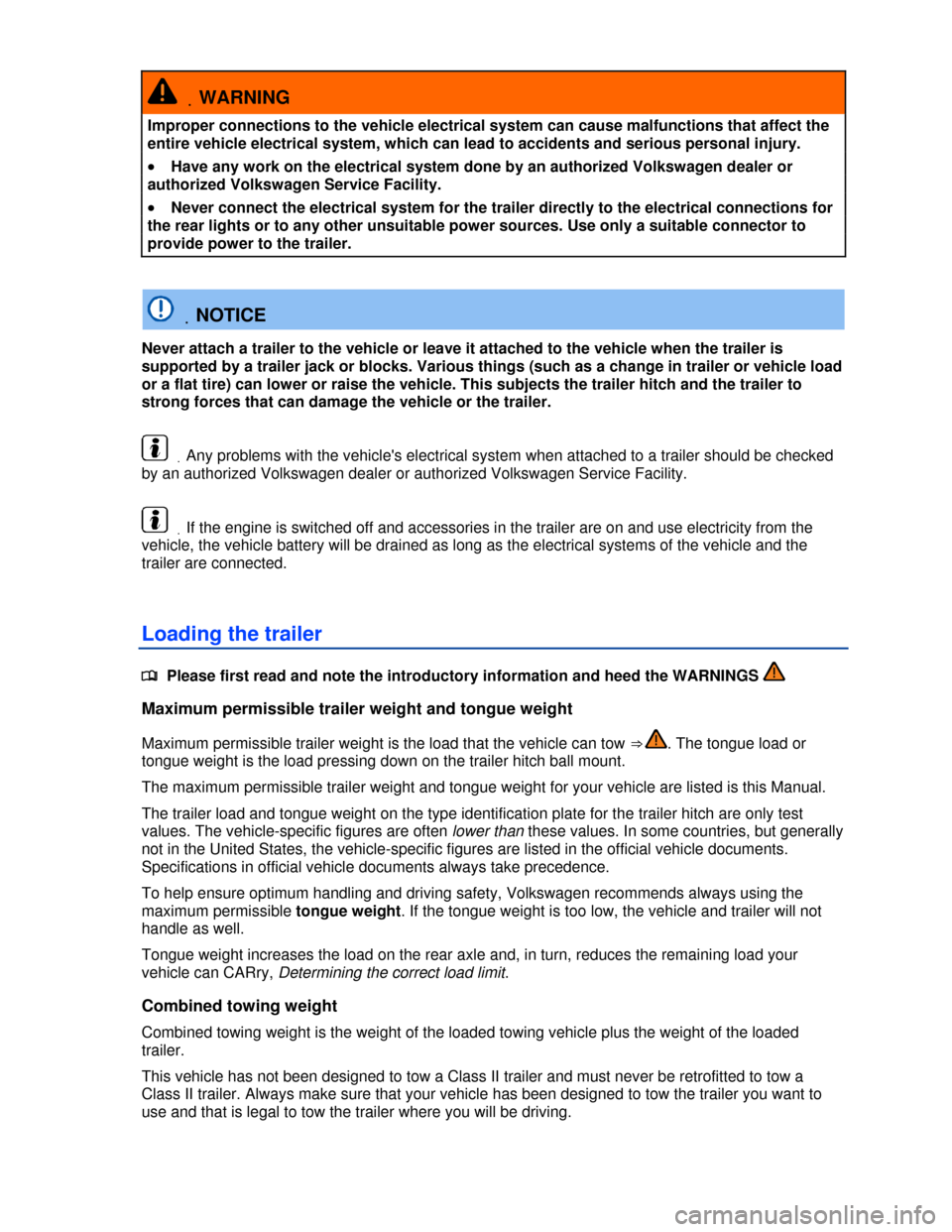
.WARNING
Improper connections to the vehicle electrical system can cause malfunctions that affect the
entire vehicle electrical system, which can lead to accidents and serious personal injury.
�x Have any work on the electrical system done by an authorized Volkswagen dealer or
authorized Volkswagen Service Facility.
�x Never connect the electrical system for the trailer directly to the electrical connections for
the rear lights or to any other unsuitable power sources. Use only a suitable connector to
provide power to the trailer.
.NOTICE
Never attach a trailer to the vehicle or leave it attached to the vehicle when the trailer is
supported by a trailer jack or blocks. Various things (such as a change in trailer or vehicle load
or a flat tire) can lower or raise the vehicle. This subjects the trailer hitch and the trailer to
strong forces that can damage the vehicle or the trailer.
.Any problems with the vehicle's electrical system when attached to a trailer should be checked
by an authorized Volkswagen dealer or authorized Volkswagen Service Facility.
.If the engine is switched off and accessories in the trailer are on and use electricity from the
vehicle, the vehicle battery will be drained as long as the electrical systems of the vehicle and the
trailer are connected.
Loading the trailer
�
Page 155 of 440
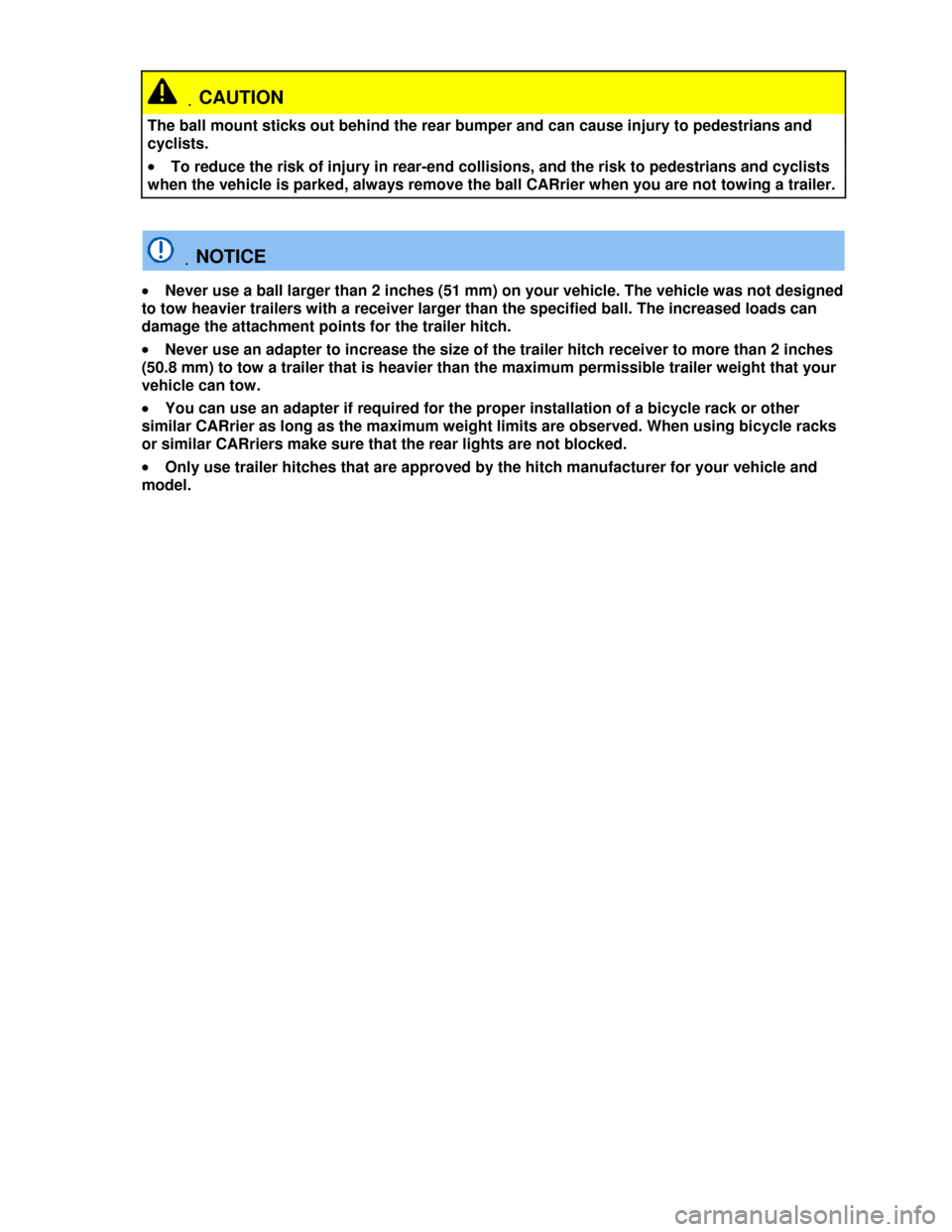
.CAUTION
The ball mount sticks out behind the rear bumper and can cause injury to pedestrians and
cyclists.
�x To reduce the risk of injury in rear-end collisions, and the risk to pedestrians and cyclists
when the vehicle is parked, always remove the ball CARrier when you are not towing a trailer.
.NOTICE
�x Never use a ball larger than 2 inches (51 mm) on your vehicle. The vehicle was not designed
to tow heavier trailers with a receiver larger than the specified ball. The increased loads can
damage the attachment points for the trailer hitch.
�x Never use an adapter to increase the size of the trailer hitch receiver to more than 2 inches
(50.8 mm) to tow a trailer that is heavier than the maximum permissible trailer weight that your
vehicle can tow.
�x You can use an adapter if required for the proper installation of a bicycle rack or other
similar CARrier as long as the maximum weight limits are observed. When using bicycle racks
or similar CARriers make sure that the rear lights are not blocked.
�x Only use trailer hitches that are approved by the hitch manufacturer for your vehicle and
model.
Page 156 of 440
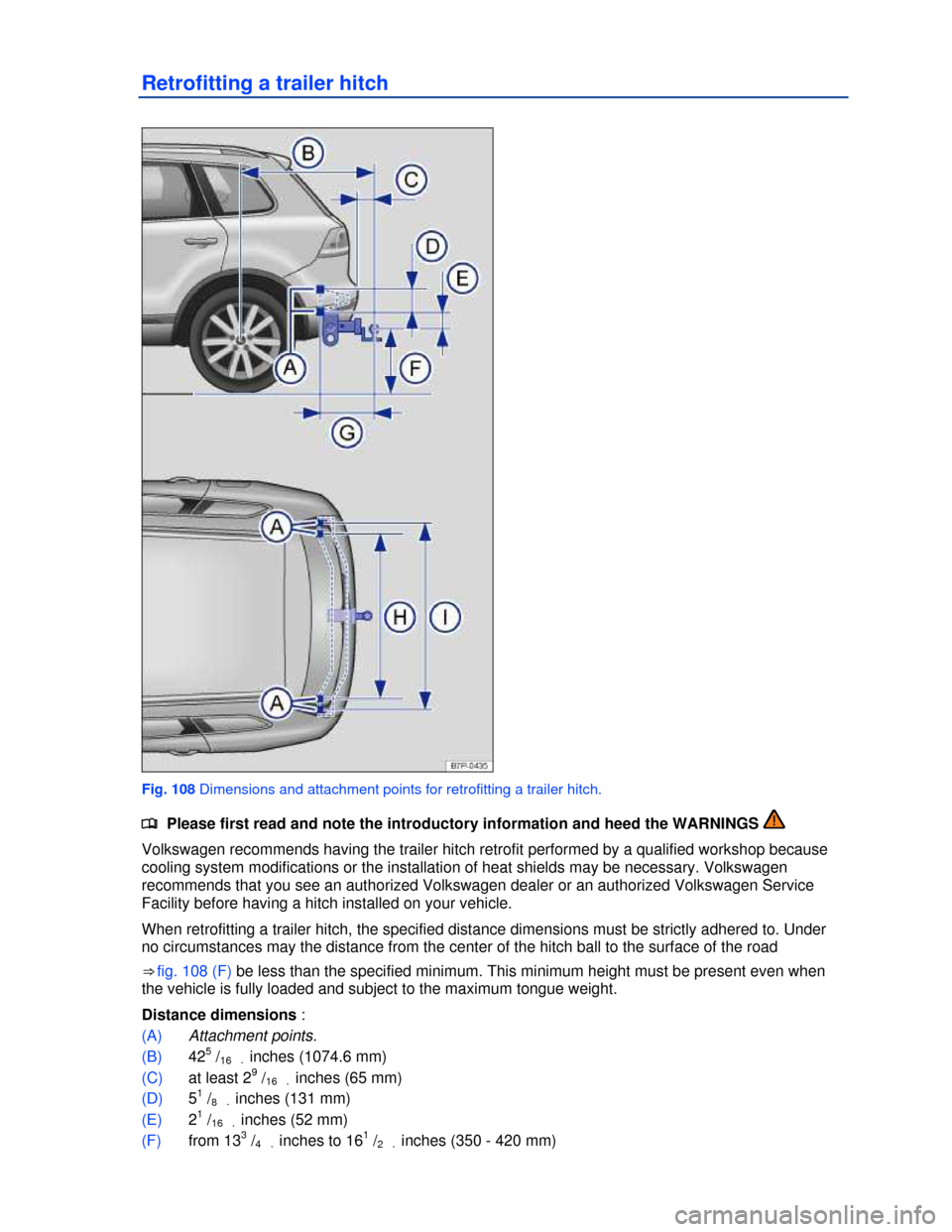
Retrofitting a trailer hitch
Fig. 108 Dimensions and attachment points for retrofitting a trailer hitch.
�